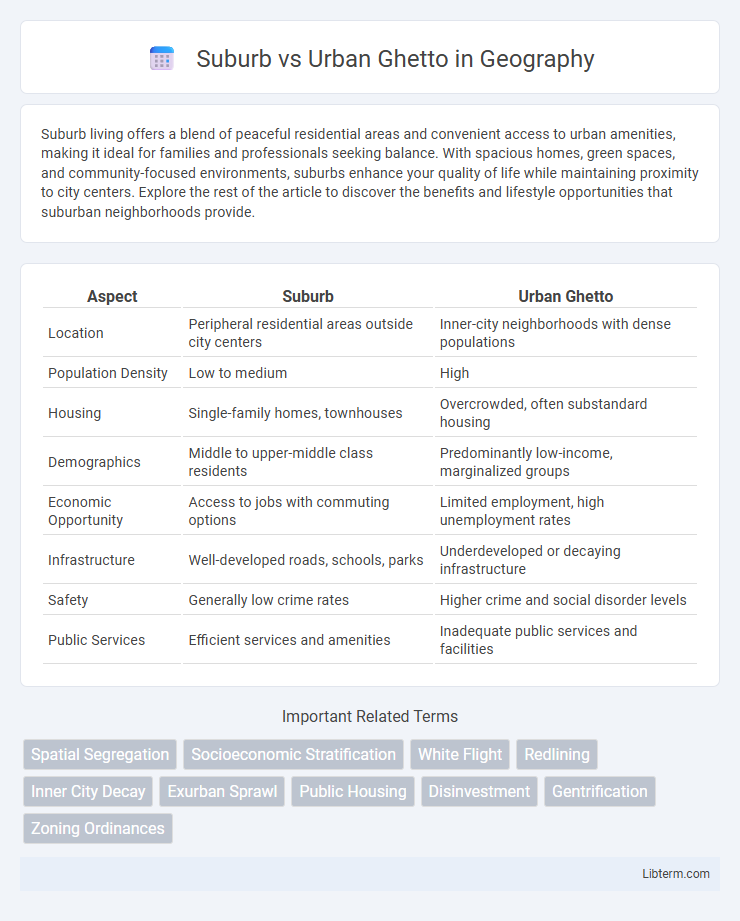Suburb living offers a blend of peaceful residential areas and convenient access to urban amenities, making it ideal for families and professionals seeking balance. With spacious homes, green spaces, and community-focused environments, suburbs enhance your quality of life while maintaining proximity to city centers. Explore the rest of the article to discover the benefits and lifestyle opportunities that suburban neighborhoods provide.
Table of Comparison
| Aspect | Suburb | Urban Ghetto |
|---|---|---|
| Location | Peripheral residential areas outside city centers | Inner-city neighborhoods with dense populations |
| Population Density | Low to medium | High |
| Housing | Single-family homes, townhouses | Overcrowded, often substandard housing |
| Demographics | Middle to upper-middle class residents | Predominantly low-income, marginalized groups |
| Economic Opportunity | Access to jobs with commuting options | Limited employment, high unemployment rates |
| Infrastructure | Well-developed roads, schools, parks | Underdeveloped or decaying infrastructure |
| Safety | Generally low crime rates | Higher crime and social disorder levels |
| Public Services | Efficient services and amenities | Inadequate public services and facilities |
Defining the Suburb and Urban Ghetto
The suburb is characterized by low-density residential areas, predominately single-family homes, and planned communities often located on the outskirts of a city. An urban ghetto is defined by higher population density, concentrated poverty, limited access to services, and often racial or ethnic segregation within a city. Both environments reflect distinct socio-economic patterns, infrastructure quality, and community resources.
Historical Development and Origins
The historical development of suburbs traces back to post-World War II economic growth, characterized by mass production of affordable housing and increased automobile ownership, promoting middle-class migration from city centers. In contrast, urban ghettos originated from systemic segregation, economic disinvestment, and discriminatory housing policies such as redlining, which confined marginalized communities to specific inner-city neighborhoods. These origins influenced starkly different social, economic, and infrastructural patterns, with suburbs embodying planned residential growth and urban ghettos reflecting entrenched spatial inequality.
Socioeconomic Differences
Suburban areas typically exhibit higher median incomes, better access to quality education, and lower unemployment rates compared to urban ghettos, where poverty and job scarcity are more prevalent. Urban ghettos often face concentrated disadvantages such as inadequate housing, limited social services, and increased crime rates, contributing to persistent socioeconomic disparities. These differences highlight the impact of systemic inequality on residents' quality of life and opportunities for upward mobility.
Housing and Living Conditions
Suburban housing typically features single-family homes with spacious yards, better building quality, and lower population density, fostering quieter and safer living conditions. Urban ghettos often contain overcrowded, deteriorating apartment buildings with limited green space and inadequate infrastructure, contributing to higher crime rates and poorer health outcomes. Access to public services and amenities also tends to be more restricted in urban ghettos, exacerbating social and economic disparities.
Community Culture and Social Life
Suburban communities often foster cohesive social networks through family-oriented events, homeowner associations, and recreational facilities that encourage interaction and collective identity. In contrast, urban ghettos typically develop vibrant, grassroots cultural expressions such as local music, street art, and community organizations that serve as vital support systems amid economic challenges. Both settings reflect distinct social life dynamics shaped by economic factors, spatial design, and historical context, influencing residents' opportunities for engagement and cultural expression.
Access to Education and Healthcare
Access to education and healthcare in suburban areas typically features well-funded schools, numerous specialized programs, and proximity to high-quality medical facilities offering diverse services. In contrast, urban ghettos often face under-resourced educational institutions with limited curriculum options and overcrowded healthcare centers struggling to meet community needs. These disparities contribute to significant gaps in academic achievement and health outcomes between suburban and urban ghetto populations.
Employment Opportunities and Economic Mobility
Suburban areas generally offer more diverse employment opportunities in sectors like technology, healthcare, and education, contributing to higher economic mobility for residents. Urban ghettos often face limited job availability, with many positions concentrated in low-wage service industries, restricting upward economic movement. Access to quality transportation and professional networks in suburbs further enhances career advancement compared to the barriers commonly experienced in urban ghettos.
Crime Rates and Perceptions of Safety
Crime rates in urban ghettos tend to be significantly higher than those in suburban areas, influenced by factors such as economic disparity, population density, and limited resources for law enforcement. Perceptions of safety in suburbs are generally more positive, often attributed to lower crime statistics, community engagement, and better infrastructure. Studies show that media portrayal and socio-economic context play crucial roles in shaping public perceptions of danger in both urban ghettos and suburban neighborhoods.
Transportation and Infrastructure
Suburban areas typically feature well-maintained roads, ample parking, and access to highways that facilitate private vehicle use, while urban ghettos often suffer from inadequate infrastructure and congested streets with limited parking. Public transportation in suburbs is generally less developed, relying heavily on cars, whereas urban ghettos depend on extensive bus and subway networks despite frequent service delays and overcrowding. Infrastructure disparities impact commute times and access to jobs, with suburbs benefiting from smoother transit routes and urban ghettos facing challenges like aging transit systems and poor sidewalk conditions.
Stereotypes and Media Representation
Media representation often paints urban ghettos as hubs of violence, poverty, and crime, reinforcing negative stereotypes that overshadow the complex realities and cultural richness of these communities. Suburbs are frequently depicted as safe, homogenous, and affluent, perpetuating notions of stability and success that ignore socioeconomic disparities and diversity within suburban neighborhoods. These reductive portrayals influence public perception, policy decisions, and social attitudes, contributing to systemic biases and the stigmatization of urban residents while idealizing suburban life.
Suburb Infographic

 libterm.com
libterm.com